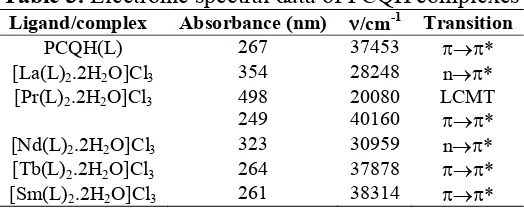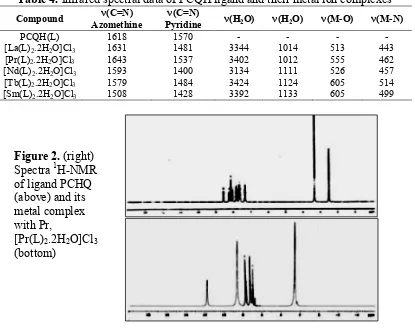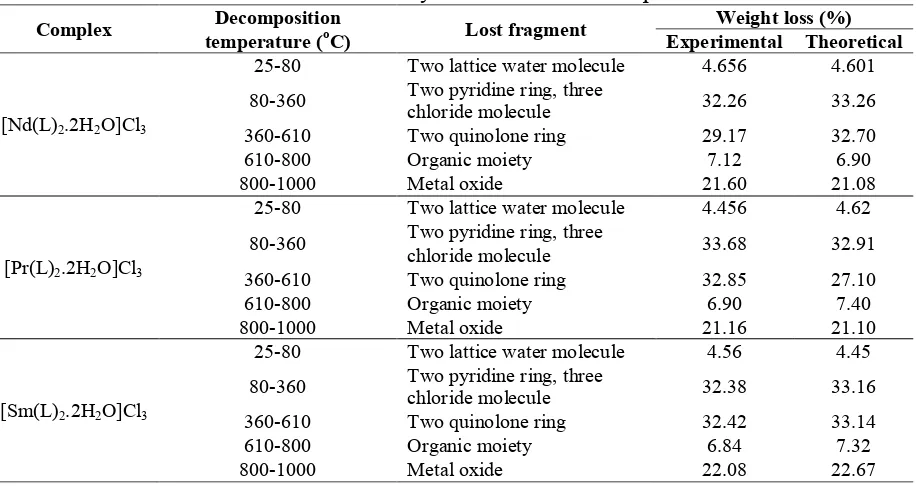The journal homepage www.jpacr.ub.ac.id p-ISSN : 2302 – 4690 | e-ISSN : 2541 – 0733
Synthesis and Spectral Characterization of Lanthanide
Complexes Containing Bidentate Schiff Base Derived From
Pyridine-2-Carbaldehyde and 2-Hydrazinylquinoline
V. R. Rajewar1, M. K. Dharmale2,*, and S. R. Pingalkar1,2
1
Department of Chemistry N.E.S.Science College, Nanded (M.S)
2
Department of Chemistry Yeshwant Mahavidyalaya, Nanded (M.S)
*
Corresponding email: [email protected]
Received 24 September 2014; Accepted 23 April 2015
ABSTRACT
A series of new rare earth complexes of La(III) of the type [Ln(L)2(H2O)2]Cl3 where Ln=
La(III), Pr(III), Nd(III), Sm(III) and Tb(III) and L=Schiff base ligand, 2-[2-(pyridin-2-ylmethylidene)hydrazinyl]quinoline (PCQH). These complexes have been characterized on the basis of elemental analysis (Ln, C, H, N, and Cl), melting point, IR, 1H-NMR and UV-Vis spectral data. X-ray powder diffraction study of two of the complex [Nd(L)2(H2O)2]Cl3
and Pr(L)2(H2O)2]Cl3 was found to be on powder diffraction with Cu-K α1 radiation (λ =
1.5406 Å) showing monoclinic crystal system . The complexes were found to be colored solid and were soluble only in DMF and DMSO.
Key word: Schiff base complexes, IR studies, 1H-NMR, UV-Vis, XRD analysis
INTRODUCTION
Compounds which contain pyridine and its derivatives or Schiff bases as ligands have occupied a central role in the development of coordination chemistry and biochemistry. Schiff base ligands form a stable complex with different transition metal ions. Schiff bases having multidentate coordination sites are known to form complexes with transition metal ions readily [1-6]. In particular, the transition metal complexes have been the subject for thorough investigation because of their extensive application in wide ranging areas from material science to biological sciences [7-9]. The formation of Schiff base intermediate in reactions of biological importance is well documented [10]. Schiff base and their metal complexes have a variety of applications in biological, clinical and analytical fields. Many potent antibacterial and antifungal Schiff base compounds of heterocyclic compounds were reported [11-14]. Some heterocyclic Schiff bases can act as antibacterial agent and antifungal agent [15-16].
chemicals and flavoring agents [26]. They are also used as polymers, catalysts, corrosion inhibitors, preservatives, and as solvent for resins and terpenes. Furthermore, these compounds find applications in chemistry of transition metal catalyst for uniform polymerization and luminescence chemistry [27]. Quinoline derivatives also act as antifoaming agent in refineries [28]. Owing to the mentioned significance, the synthesis of substituted quinolines has been a subject of great interest in organic chemistry.
The synthesis of quinolines and their derivatives has been of considerable interest because a large number of natural products and drugs contain this heterocyclic unit [29].Quinolines and their derivatives are receiving increasing importance due to their wide range of biological activities as anti-malarial, anti-bacterial, antiasthmatic, antihypertensive, anti-inflammatory, anti-platelet activity and as tyro-kinase PDGF-RTK inhibiting activity [30-32]. In addition, quinolines have also been employed in the study of bioorganic and bio-organometallic processes [33]. Due to such a wide range of applicability in medicinal, bioorganic, industrial as well as in the fields of synthetic organic chemistry, there has been increasing interest in the development of efficient methodologies for the synthesis of quinolones [34-37].
EXPERIMENT
Chemicals and instrumentation
All chemicals and solvents are used AR grade. All the metals were used as their chloride salts. UV spectra recorded on UV-vis spectrophotometer 119. Conductance or metal complex was determined in DMSO on conductivity meter quiptronics model NOEQ665. Melting points were recorded on in recorded by open capillary method and are uncorreded.
1
H-NMR spectra or a Schiff base and its metal complex recorded on Brucker 300 MHz spectrometer in DMSO. Elemental analysis was carried out on Eager 350 analyser. Magnetic measurements were done on solid complexes using Guoy method. Powder XRD pattern of complexes are recorded Philips Analytical XRD B.V. at CFC Shivaji University Kolhapur.
Preparation of 2-[2-(pyridin-2-ylmethylidene)hydrazinyl]quinoline (PCQH) Schiff base
The Schiff base ligand was synthesized by condensation of pyridine-2-carbaldehyde (0.01 M) and 2-hydrazinylquinoline (0.01 M) in 50 mL ethanol was refluxed on water bath for 4-5 hours in presence of 2-3 drops of glacial acetic acid. The reaction mixture was kept overnight, and faint pink precipitate was obtained. Then, Schiff base was filtered, washed with ethanol. It is dried in vacuum desiccator and recrystallized from ethanol. The purity of Schiff base was checked by TLC.
Figure 1. Reaction scheme for preparation the Schifs base
Preparation of metal complexes, [La(L)2.2H2O]Cl3 Complex
complex was allowed to settle and collected by filtration, washed with warm ethanol. Then dried in vacuum dessicator and recorded the yield.
Preparation of metal complex, [Pr(L)2.2H2O]Cl3 complex
The aqueous solution of PrC13 (0.01 M) in hot ethanolic. Also, ligand (PCQH) 0.02 M
was dissolved in hot ethanolic solution. The aqueous solution of metal chloride was added to the ligand drop wise with constant stirring. The pH of reaction mixture was adjusted about 6.8 to 7.0 by putting alcoholic ammonia drop by drop. The resulted reaction solution was refluxed for four to five hours on water bath. The dull yellow precipitate was allowed to settle down. It is filtered through Whatmann filter paper. The complex was purified in warm ethanol. The metal complex was dried in a vacuum dessicator and the yield were recorded and stored in the glass sample bottle.
Preparation of metal complex, [Nd(L)2.2H2O]Cl3 complex
A molar solution of neodymium chloride and ligand (PCQH) were prepared by dissolving weighed amounts in ethanol. These solutions were then mixed each other in 1:2 ratios with constant stirring. By adding alcoholic ammonia PH of the reaction mixture was adjusted to 7.0 and refluxed on water bath for four to five hours. Coffee color precipitate appears. The precipitate of complex were filtered and purified by washing with warm ethanol. Then complex is dried in dessicator and record the yield.
Preparation of metal complex,[Tb(L)2.2H2O]Cl3 complex
Weight amount of TbC13 0.01 M were prepared in ethanol. Also ligand (PCQH) 0.02
M were dissolved in hot ethanolic solution. The metal chloride solution was added to the ligand drop by drop with constant stirring. The reaction pH was maintained at 6.9 to 7.1 by adding alcoholic ammonia. The resulting reaction mixture was refluxing on water bath for 4 to 5 hours. The dull brown precipitate of complex was digested, separated by filtration and then washed with warm ethanol and dried in vacuum at room temperature.
Preparation of metal complex, [Sm(L)2.2H2O]Cl3 complex
A molar solution of samarium chloride and ligand (PCQH) were prepared dissolving weighed amounts in ethanol. These solutions were then mixed each other in 1:2 ratios with constant stirring. By adding alcoholic ammonia, pH of the reaction mixture was adjusted to 7.0 and refluxed on water bath for 4 to 5 hours. Dark brown color precipitate appears. The precipitate of complex were filtered and purified by washing with warm ethanol. Then complex is dried in desiccators and record the yield.
RESULT AND DISCUSSION Physical and analytical parameters
Physical parameters of the complexes such as molar conductance, decomposition point, chloride percentage, metal ligand ratio are listed in the Table 1. Complexes are intensively colored, insoluble in water and common organic solvents but soluble in DMSO and DMF. They decompose above 2700 oC, and suggesting good thermal stability at normal condition [38]. Molar conductance of La(III), Pr(III), Nd(III), Tb(III) and Sm(III) complexes (λm 114
and 120 Ω-1
H, N), metal ion (Table 1.2) and thermal measurements empirical formula of the complexes was deduced.
Table 1. Physical and analytical data of PCQH metal complexes.
Compound F.W. Yield ML
Table 2. Percent of C, H, N,O and metal ion in PCQH metal complexes
Compound Empirical
The electronic spectra of ligand and complexes are recorded in the range 200 to 1000 nm with UV-Visible spectrophotometer 119-PC based instrument in DMSO solvent from Department of Microbiology, Pharmacy College Nanded. The ligand (PCQH) shows strong absorption band at 37453 cm‐1 assigned for ππ∗ transition. Absorption bands and corresponding transition are given in the Table 3.
Table 3. Electronic spectral data of PCQH complexes Ligand/complex Absorbance (nm) /cm-1 Transition
Infrared spectra of metal complex
The Infrared spectra of ligand and metal complexes provide some information regarding the bonding in the compounds. Important absorption frequencies of ligand and complexes along with their assignments are presented in the Table 4.
IR spectra of PCQH (L) Ligand shows strong band in the region of 3165 cm-1 which is
assigned to ν (O-H) stretching vibration of phenolic group. A band due to ν (N=CH) stretching vibrations in ligand appears at 1618 cm-1. A band due to ν (N=CH) of pyridine stretching vibrations in ligand appears at 1570 cm-1.
The IR,spectra of complexes compared with ligand, the strong band at 3134 to 3424 cm-1 observed in complex due ν (O-H) of water molecule [44]. The water molecule is also confirmed the band present at 1012 to 1133 cm-1 due to ν (H2O) rocking vibration. Band present in ligand at 1618 cm-1due to ν (CH=N) vibration shifted to frequency at 1508 to 1643 cm-1 indicating the involvement of azomethine group in coordination [45,46]. Band present in ligand at 1570 cm-1 due to ν (CH=N) vibration of pyridine shifted to frequency at 1400 to 1537 cm-1 indicating the involvement of this group in coordination. The new bands observed in complex in the region 400-600 cm-1 attributable to ν (M-N) and ν (M-O) band stretching respectively [47,48].
Table 4. Infrared spectral data of PCQH ligand and their metal ion complexes
Compound (C=N)
Azomethine
(C=N)
Pyridine (H2O) (H2O) (M-O) (M-N)
PCQH(L) 1618 1570 - - - -
[La(L)2.2H2O]Cl3 1631 1481 3344 1014 513 443
[Pr(L)2.2H2O]Cl3 1643 1537 3402 1012 555 462
[Nd(L)2.2H2O]Cl3 1593 1400 3134 1111 526 457
[Tb(L)2.2H2O]Cl3 1579 1484 3424 1124 605 514
[Sm(L)2.2H2O]Cl3 1508 1428 3392 1133 605 499
Figure 2. (right) Spectra 1H-NMR of ligand PCHQ (above) and its metal complex with Pr,
[Pr(L)2.2H2O]Cl3
(bottom)
Proton-NMR spectra
azomethine in free ligand at δ 8.7 ppm is shifted to down field region [50] at δ 11.8 ppm in
metal complex (Figure 2-bottom). A new peak observed at δ 2.2-4.2 ppm in complex due to corresponding water molecule [51]. Thus, DPMDI molecule seems to be coordinated to the metal ions through azomethine and water molecule.
Thermogravimetric Analysis
Thermogravimetric analysis (TGA and DSC) of metal complexes are used to i) get information about the thermal stability of new complexes, ii) decide whether the water molecules are inside or outside the inner co-ordination sphere of the central metal ion and iii) suggest a general scheme for thermal decomposition of chelates. In the present investigation, heating rates were suitably controlled at 10°C min-1 under nitrogen atmosphere and the weight loss was measured from the ambient temperature upto 1000°C. The TGA data are presented in Table 5. The TGA curve of the Nd(III) complexes (Figure 3A) showed a rapid first step decomposition around 80°C with 4.6 % mass loss (calculated 4.6%) indicating the loss of two lattice water molecules [52]. The complex %.[Nd(L)2.2H2O]Cl3 shows a weight
loss of 32.26% at a temperature range 360 °C which corresponds to the removal of two pyridine ring and three chloride molecule. A weight loss of 29.17% is observed in the temperature range 360-610 °C which suggests the elimination of coordinated two quinoline ring, and from 610-8000 oC, 7.23% metal oxide is removed [49]. In the Nd-complex the amount of residue is 21.60% [53].
Table 5. Thermal Analysis data for metal complexes
Complex Decomposition
temperature (oC) Lost fragment
Weight loss (%) Experimental Theoretical
[Nd(L)2.2H2O]Cl3
25-80 Two lattice water molecule 4.656 4.601 80-360 Two pyridine ring, three
chloride molecule 32.26 33.26 360-610 Two quinolone ring 29.17 32.70 610-800 Organic moiety 7.12 6.90 800-1000 Metal oxide 21.60 21.08
[Pr(L)2.2H2O]Cl3
25-80 Two lattice water molecule 4.456 4.62 80-360 Two pyridine ring, three
chloride molecule 33.68 32.91 360-610 Two quinolone ring 32.85 27.10 610-800 Organic moiety 6.90 7.40 800-1000 Metal oxide 21.16 21.10
[Sm(L)2.2H2O]Cl3
25-80 Two lattice water molecule 4.56 4.45 80-360 Two pyridine ring, three
The TGA curve of the Sm(III)-complexes (Figure 3C) showed a rapid first step decomposition around 70 °C with 4.5% mass loss (calculated 4.4%) indicating the loss of two lattice water molecules [56]. The complex [Sm(L)2.2H2O]Cl3 shows a weight loss of 32.38%
at a temperature range 370 °C which corresponds to the removal of of two pyridine ring ligand and three chloride molecule. A weight loss of 32.42% is observed in the temperature range 370-610 °C which suggests the elimination of two quinoline ring. From 610-8000 oC, 6.8 % organic moiety is removed. In the Sm-complex the amount of metal oxide is 22.08% [57].
Figure 3. The DSC-TGA data of metal complex: (A) [Nd(L)2.2H2O]Cl3;
(B) [Pr(L)2.2H2O]Cl3; and (C) [Sm(L)2.2H2O]Cl3
Figure 4. X-ray diffractogram of metal-complex [Nd(L)2.2H2O]Cl3
Figure 5. X-ray diffractogram of metal-complex [Pr(L)2.2H2O]Cl3
X-Ray analysis
Powder XRD patterns of the selected complexes recorded in the 2θ range from 10 to 900 at wave length 1.5405 A° using Cu Kα radiation source. Miller indices and interplanar
distances are then determined indexing major difractograms. Lattice parameter a, b, c, and α,
β, γ are computed from program. Data has been summarized in the following Table 6 dan 7,
meanwhile the diffractograms are showed in Figure 4 and 5, respectively.
The cell data and crystal cell parameter for metal complex [Nd(L)2.2H2O]Cl3 was
Table 6. The lattice parameter of metal complex [Nd(L)2.2H2O]Cl3
Table 7. The lattice parameter of metal-complex [Pr(L)2.2H2O]Cl3
In addition, the cell data and crystal parameter for metal complex [Pr(L)2.2H2O]Cl3 are
displayed in Figure 5 and Table 7. It was result that crystal system: monoclinic, lattice type: P, lattice parameter: a= 12.91538 b= 4.54932 c= 6.64278 Ao, and lattice parameter: = 90.000 = 134.080 = 90.000. This result is attributed to monoclinic crystal system [59].
Structure for
[Nd(L)2.2H2O]Cl3 complex
Structure for [Pr(L)2.2H2O]Cl3 complex
Structure for
[Sm(L)2.2H2O]Cl3 complex
CONCLUSION
To summarized, a series of new rare earth complexes of La(III) has been synthesized. They have type [Ln(L)2(H2O)2]Cl3 where Ln= La(III), Pr(III), Nd(III), Sm(III) and Tb(III)
and L=Schiff base ligand, 2-[2-(pyridin-2-ylmethylidene)hydrazinyl]quinoline (PCQH)]. The resulted metal complex has been characterized their spectral data including the elemental analysis (Ln, C, H, N, and Cl), melting point, IR, 1H-NMR and UV-Vis spectral data. The X-ray powder diffraction study of two of the complex [Nd(L)2(H2O)2]Cl3 and Pr(L)2(H2O)2]Cl3
was found to be on powder diffraction with Cu-K α1 radiation (λ = 1.5406 Å) showing monoclinic crystal system.
REFERENCES
[1] K.Ueno, A.E. Martell, J. Phys. Chem, 1955, 59, 998. [2] K.Ueno, A.E.Martell, J. Phys. Chem, 1956, 60, 1270.
[3] H. Ōkawa, A. Honda, M. Nakamura and S. Kida, J. Chem. Soc., Dalton Trans, 1985, 59.
[4] R. Atkins, G. Brewer, E. Kokot, G. M. Mockler, and E. Sinn, Inorg. Chem., 1985, 24, 127.
[5] Fred C. Anson, Terrence J. Collins, Stephen L. Gipson, John T. Keech, Terry E. Krafft, and Geoffrey T. Peake, J. Am. Chem. Soc., 1986, 108, 6593
[6] C.M. Che, W.K. Cheng, J. Chem. Soc. Chem. Commun., 1986, 1443
[7] E. Tselepi-Kalouli, N. Katsaros, E. Sidris., Inorg .Chem. Acta, 1986, 124, 181. [8] P. Tamilselvi, M. Palaniandavar., Inorg. Chem. Acta, 2002, 337, 420.
[9] N. Raman, V. Muthuraj, V. Ravichandran and S. Kulandaisamy, J. Chem. Sci., 2003, 115, 161-167.
[10] I. S. Raj, M. Christudhas and G. A. G. Raj., J. Chem. Pharm. Res., 2011, 3(6), 127-135. [11] G. G. Mohamed, and M. M. Omar., Spectrochim, Acta: part A, 2005, 62,1140.
[12] A. Scozzafava, L. Menabuoni, F. Minicone, G. Mincione, C. T. Supran., Biorg. Med.
Chem. Lett.,2001, 11, 575.
[13] M. S. Sastry, R. Ghose, A. K. Ghose., Bull .Chem. Soc. Ethiop., 1990, 4, 61.
[14] N. Raman, S. Thalamuthu, J. Dhaveethuraja, M. A. Neelakandan, S. J. Banerjee., Chil.
Chem. Soc, 2008, 53, 21.
[15] V. Mishra, D. K. Sena, M. C. Jain., Synth. React. Inorg. Met. Org. Chem., 1987, 17, 987-1002.
[16] S. R. Bhusare, V. G. Pawer, S. B. Shinde, R. P. Pawer and Y. B. Vibhute., Int. J. Chem. Sci.2003, 1, 31-36.
[18] El-Sonbati A. Z., Synth. React. Inorg. Met.-Org. Chem., 1991, 21, 1469 (1991); (b)
[26] B. S. Holla, M. Mahalinga, M. S. Karthikeyan, P. M. Akberalib, N. S. Shettyc, Bioorg.
Med. Chem., 2006, 14, 2040–2047.
[35] Kidwai, Mazaahir, V. Bansal, N. K. Mishra, and D. Bhatnagar, Indian. J. Chem. Sect.
B., 2009, 48B, 746-748.
[36] Wang, J. F., C. C. Zhang, K. C. Chou, and D. Q. Wei, Curr. Med. Chem. 2009, 16, 2, 232-244.
[37] Roma G., Braccio M. D.G. Grossi, F. Mattioli, and M. Ghia, Eur. J. Med. Chem.2000, 35, 1021.
[38] Rosu, T., Pahontu, E., Maxim, C., Georgescu, R., Stanica, N., Gulea, A., Polyhedron,
[46] Al-Sabti, M. D., Al-Amiery, A. A. H., Al-Majedy, Y. K., Ali, A., Jornal of Biotechnology Reserch Center, 2009, 3 (2), 1-12.
[47] Reddy, R. K., Suneetha, K., Karigar, P., Manjunath, C. S., and Mahendra, K. N., J.
Chil. Chem. Soc., 2008, 53, 4, 1653.
[48] Deshmukh, J. H. and Deshpande, M. N., I.J.C.E.P.R., 2011, 2 (1), 20.
[49] Lee, S. H., K. R. Kim, J. S. Shon, J. H. Yoo, and H. Chung, J. Ind. Eng. Chem., 1999, 5, 4, 296-301.
[50] S. Foroush, L. A., Aminkhani, A., Ershad, S., Karimnezhad, G., Ghammamy, S. and Kabiri, R., Molecules, 2008, 13, 804.
[51] Pingalikar, S. R. and Deshpande, M. N., Orient. J. Chem., 2007, 23(1), 265. [52] Maurya, R. C., Choursia, J. and Sharma, P., Indian J. Chem., 2007, 46A, 1594.
[53] Machado, L. C., Morigaki, M. K., Lopes, A. A., Jose, M. E., Muri, B., Quim. Nova, 2002, 25 (6), 897.
[54] J. Li, C. C. Ji, L. F. Huang, Y. Z. Li and H. G. Zheng, Inorg. Chim. Acta., 2011, 371(1), 27.
[55] Manimekalai, R., Int. J. App. Bio. Pharm. Tech.,2011, 2(2).
[56] M. Gaber and S. S. Al-Shihry, Department of Chemistry, College of Education, King Faisal University, Saudi Arabia.
[57] Mohammed, S. F., J. Am. Sci., 2010, 6(10), 1032.
[58] Gigant, K., Rammal, A. and Henry, M., J. Am. Chem. Soc.,2001, 123, 11632.




![Figure 3. The DSC-TGA data of metal complex: (A) [Nd(L)2.2H2O]Cl3; (B) [Pr(L).2HO]Cl; and (C) [Sm(L).2HO]Cl](https://thumb-ap.123doks.com/thumbv2/123dok/2861237.1694393/7.595.72.528.219.523/figure-dsc-tga-data-metal-complex-nd-cl.webp)
![Table 6. The lattice parameter of metal complex [Nd(L)2.2H2O]Cl3](https://thumb-ap.123doks.com/thumbv2/123dok/2861237.1694393/8.595.119.476.321.578/table-lattice-parameter-metal-complex-nd-l-cl.webp)